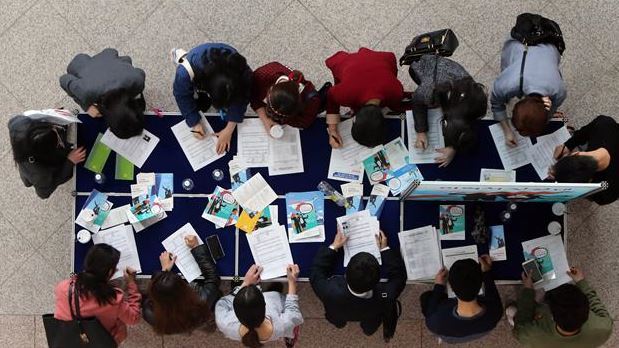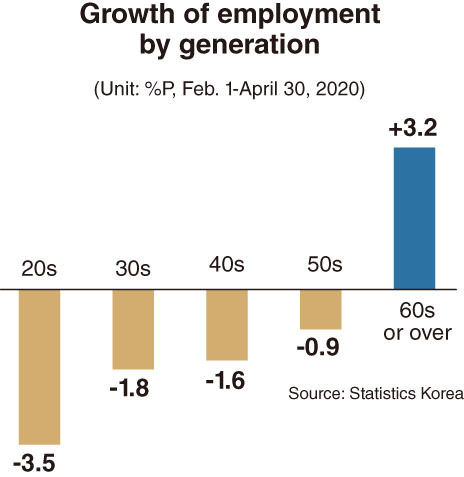
Job fair participants fill out application forms at Daejeon City Hall. (Yonhap)
SEJONG -- While the novel coronavirus has dealt a serious blow to people of all ages in terms of employment in South Korea, it has hit younger people especially hard.
According to Statistics Korea, the employment rate among those in their 20s stood at 54.6 percent as of April, down 3.5 percentage points from 58.1 percent in January, when the nation reported its first case of COVID-19.
For people between the ages of 20 and 29, the employment rate posted its steepest decline.
Next were people between 15 and 19, for whom the employment rate fell by 2.9 percentage points over the corresponding period, from 8.1 percent to 5.2 percent.
Those in their 30s were the third-hardest hit, with the employment rate for that age group declining 1.8 percentage points, followed by those in their 40s with a decline of 1.6 percentage points and those in their 50s with a drop of 0.9 percentage point.

(Graphic by Kim Sun-young/The Korea Herald)
In contrast, the employment rate for those in their 60s or over climbed 3.2 percentage points, from 38.6 percent in January to 41.8 percent in April.
The plunge in the employment rate among the young is attributed to a hiring freeze for high school and college graduates during the first quarter, said a labor research analyst in Seoul.
He said a large number of young people were thought to have moved from the underemployed category to unemployed when their temporary jobs disappeared.
“Nonetheless, the situation could be more serious among the middle-aged, who are in charge of households,” he said.
Another set of data demonstrates the critical nature of the situation for younger people.
According to the Supplementary Index III for Employment, held by Statistics Korea, the de facto jobless rate among those aged 15-29 was 26.6 percent.
The index provides a relatively new method of calculating unemployment, counting underemployed people among the de facto unemployed. This category includes those who work fewer than 36 hours a week and want to work more, as well as seasonal workers who are out of work for part of the year.
Collectively, unemployed and underemployed youth tallied 1.26 million as of April, out of an economically active population of 4.74 million for the same age group.
The corresponding figures for January were 1.04 million and 4.87 million, meaning the number of de facto unemployed in this age group increased by more than 210,000 over the past three months.
Last month the Moon Jae-in administration pledged to create 550,000 jobs as part of a 10 trillion won ($8.06 billion) plan. But many online commenters criticized the plan, calling it a waste of taxpayers’ money and predicting that it would create mostly temporary jobs in the public sector.
The Moon administration, since taking office in May 2017, has spent about 50 trillion won on job creation, reflecting its electoral pledge to generate 810,000 jobs in the public sector and resolve the youth unemployment crisis.
But these efforts produced a number of temporary jobs at state-funded agencies for seniors in their 60s or over.
Some economists attribute the high youth jobless rate to a drastic hike in the minimum wage, which increased labor costs for small businesses. The monthly minimum wage, which was 1.35 million won in 2017, increased to 1.74 million won in 2019.
This was part of the Moon government’s policy of income-led growth, which has drawn mounting criticism.
Korea posted a 66.8 percent employment rate among those aged 15-64. The average for the 36-member Organization for Economic Cooperation and Development stood at 69.1 percent, and the average for the Group of Seven was 72.2 percent.
The nation ranked No. 28, the same spot it occupied in the first half of 2019.
By Kim Yon-se (kys@heraldcorp.com)





![[From the Scene] Monks, Buddhists hail return of remains of Buddhas](http://res.heraldm.com/phpwas/restmb_idxmake.php?idx=645&simg=/content/image/2024/04/19/20240419050617_0.jpg&u=20240419175937)

